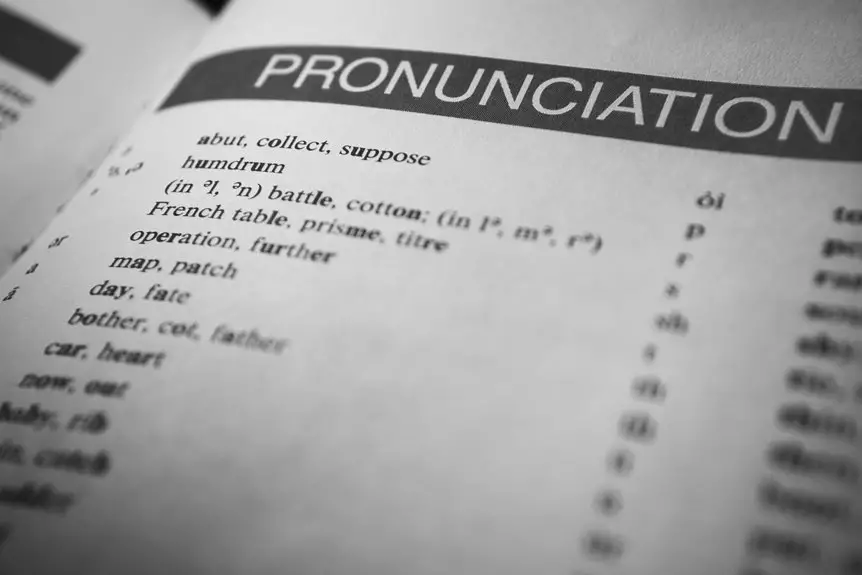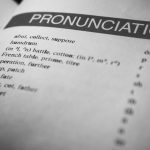You pronounce bouclé as “boo-klay,” with two syllables and emphasis on the second one. Say the “bou” like the “oo” in “food,” but softer, and the “clé” like “klay,” rhyming with “play.” Remember, the French accent on the “é” gives it a clear “ay” sound, so avoid saying “boo-klee” or “boo-clay.” If you want to sound confident using bouclé in fashion or design, you’ll find a few helpful tips coming up.
Table of Contents
Key Takeaways
- Pronounce “bouclé” as two syllables: “boo” (soft “oo” sound) and “klay,” with emphasis on the second syllable.
- The “ou” sounds like the soft “oo” in “food,” not a harsh “oo.”
- The accented “é” is pronounced like a short “ay” as in “say,” never silent.
- Avoid saying “boo-klee” or “boo-clay”; instead, say “boo-klay” with a soft ending.
- Listen to native speakers via Forvo or Merriam-Webster to master the correct French pronunciation.
Origin of the Word Bouclé
Although you might hear “bouclé” often in fashion and textiles, its origin traces back to French, where it means “curled” or “ringed.”
You’ll find that the term originally described the looped or curled texture of yarn or fabric. This word perfectly captures the distinctive look of bouclé fabric, which features small loops or curls on its surface.
When you use this term, you’re tapping into a rich linguistic history tied to the tactile qualities of materials. Knowing this origin helps you appreciate why bouclé is associated with that unique, textured appearance.
Understanding the French Pronunciation Rules
To pronounce Bouclé correctly, you’ll need to grasp some key French pronunciation rules.
Pay attention to French vowel sounds, the common silent letters, and how accents change pronunciation.
Once you understand these elements, saying Bouclé will feel much more natural.
French Vowel Sounds
Mastering French vowel sounds is key to pronouncing words like “bouclé” correctly. French vowels differ from English; they’re pure and don’t glide. For example, the “ou” in “bouclé” sounds like the English “oo” in “food,” not “ow” as in “cow.”
The “é” at the end is pronounced like “ay” in “say,” but shorter and crisper. French also uses nasal vowels, but “bouclé” doesn’t have one, so you can focus on clear, distinct vowel sounds.
To get it right, listen closely to native speakers and mimic their mouth movements. Practicing these vowel sounds will make your French pronunciation more authentic and help you say “bouclé” with confidence.
Silent Letter Rules
When you learn French, you’ll notice many letters at the end of words go unpronounced, and “bouclé” is no exception. Silent letters often confuse learners, but understanding a few rules makes it easier. Here’s what you should remember:
- Final consonants are usually silent unless followed by a vowel in liaison. For example, the “t” in “bouclé” is silent.
- Silent letters often appear at the end of words to indicate grammatical gender or tense but don’t affect pronunciation.
- French words ending in -é, like “bouclé”, usually pronounce the final vowel sound, while the consonant remains silent.
Knowing these silent letter rules helps you pronounce “bouclé” accurately and recognize similar patterns in other French words.
Accent Influence on Pronunciation
Understanding silent letters sets a foundation for grasping how accents shape pronunciation in French. When you see accents like the acute (é), grave (è), or circumflex (ê), they signal changes in vowel sounds and stress.
For example, the accent aigu (é) in “bouclé” tells you to pronounce the “e” as a clear, closed “ay” sound, not a muted or silent vowel. Without this accent, the pronunciation shifts, often becoming softer or even silent.
Accents also help you distinguish words with similar spellings but different meanings. So, when you pronounce bouclé, the accent guides you to a sharper, more precise ending.
Paying attention to these accents guarantees you speak French words accurately and confidently.
Breaking Down the Syllables of Bouclé
You’ll want to break “Bouclé” into two clear syllables: “bou” and “clé.”
Focus on pronouncing each part distinctly while giving the accent to the second syllable. This stress pattern helps you sound natural and accurate in French.
Syllable Pronunciation Breakdown
Breaking down the word “bouclé” into syllables makes its pronunciation much easier to grasp. You’ll notice it has two clear syllables: bou-clé.
Here’s how to tackle each:
- Bou – Pronounce this like “boo,” with a long “oo” sound, similar to “boot.”
- Clé – This sounds like “clay” but with a softer ending; it’s pronounced “klay,” rhyming with “play.”
- Put it together smoothly: “boo-klay.”
Focusing on each syllable separately helps you say the word confidently. Remember, the “é” at the end signals a distinct “ay” sound, so don’t skip it.
Stress and Accent Patterns
Stress plays a key role in pronouncing “bouclé” correctly, so you want to place emphasis on the second syllable, “clé.” This accent pattern gives the word its natural French rhythm, making it sound smooth and authentic.
When you say it, start lightly on the first syllable “bou” and then strengthen your voice on “clé,” almost as if you’re highlighting it. Avoid stressing the first syllable since that can make the word sound off or anglicized.
Paying attention to this stress pattern helps you capture the word’s elegance and makes your pronunciation more accurate. So, remember: light on “bou,” strong on “clé.” Mastering this will have you saying “bouclé” like a native in no time.
How to Pronounce the “Bou” Part
The “Bou” part of bouclé sounds like “boo,” similar to the start of “bouquet” or “boost.” When you say it, keep the vowel sound long and smooth, without adding extra syllables or emphasis.
To pronounce it correctly, focus on these points:
- Lengthen the vowel – Hold the “oo” sound gently to avoid cutting it short.
- Avoid extra sounds – Don’t add a “w” or “uh” after “boo”; keep it clean and direct.
- Match familiar words – Think of “boo” in “boot” or “boost” as your guide.
How to Pronounce the “Clé” Part
Pronouncing the “clé” part of bouclé can feel tricky, but it’s simpler than you might think. The “clé” sounds like “clay” without the “ay” — basically just “clay” but shorter and crisper. It’s a French word meaning “key,” so the accent on the “é” makes the “e” sound like “ay.” When you say “clé,” stress the syllable lightly, keeping it smooth and clear.
Here’s a quick guide:
| Letter(s) | Sound | Example |
|---|---|---|
| c | k | cat |
| l | l | lamp |
| é | ay (short) | café |
Try blending these sounds together, and you’ll master the “clé” in no time!
Common Mistakes When Pronouncing Bouclé
Although bouclé might look straightforward, many people trip up on its pronunciation. You might be tempted to say “boo-klee” or “boo-clay,” but those aren’t quite right.
Bouclé seems simple but often gets mispronounced—avoid saying “boo-klee” or “boo-clay” for accuracy.
Here are common mistakes to avoid:
- Mispronouncing the “ou” as a long “oo” sound; it should sound more like “boo” but softer.
- Overemphasizing the “clé” by pronouncing it like “clay”; instead, say it softly as “klay” with a subtle “ay” sound.
- Ignoring the accent on the “é”, which changes the ending sound, so don’t pronounce it like a silent or flat “e.”
Audio Examples to Hear Bouclé Pronounced Correctly
Hearing bouclé pronounced correctly can make all the difference in mastering its sound. Listening to native speakers helps you grasp the subtle nuances and avoid common errors. To get you started, here are some reliable audio examples you can use:
| Source | Description |
|---|---|
| Forvo | User-recorded pronunciations |
| Merriam-Webster | Professional audio guide |
| YouTube | Video pronunciation tutorials |
Try repeating after each clip to practice the rhythm and intonation. Focus on the soft “clay” sound at the end, which is often missed. These audio resources are easily accessible and perfect for reinforcing your pronunciation. Keep revisiting them until you feel confident saying bouclé aloud without hesitation.
Using Bouclé in Everyday Conversation
Now that you’ve familiarized yourself with how bouclé sounds, you can start incorporating it into everyday conversation. Using the word confidently helps you connect, especially when discussing textures or materials.
Here’s how you can do it effectively:
- Describe Fabrics: When talking about clothing or upholstery, mention bouclé to highlight its unique looped texture.
- Share Experiences: Use bouclé to describe anything with a similar bumpy or curly feel, making your descriptions vivid.
- Ask Questions: If you’re unsure whether a fabric is bouclé, asking shows your interest and helps reinforce the pronunciation.
Practice these tips, and you’ll sound natural and knowledgeable when bouclé comes up in chats.
Practice these tips to sound confident and natural whenever bouclé enters the conversation.
Don’t hesitate to use it often—it’ll soon become part of your everyday vocabulary.
Bouclé in Fashion and Design Terminology
Bouclé plays a key role in fashion and design terminology, especially when describing fabric textures that add depth and character to garments and interiors. When you hear “bouclé,” think of a looped yarn fabric that’s tactile and visually rich. Designers often choose bouclé for jackets, upholstery, and throws because it offers warmth and a distinctive look. Understanding its uses helps you appreciate the fabric’s versatility.
| Term | Description | Common Use |
|---|---|---|
| Bouclé | Loop yarn fabric with texture | Jackets, upholstery |
| Texture | Surface feel and appearance | Enhances design |
| Yarn | Thread used in fabric weaving | Base of bouclé |
| Upholstery | Covering furniture with fabric | Sofas, chairs |
| Garment | Clothing item | Jackets, coats |
Tips for Remembering the Pronunciation
Although the word may look tricky at first, you can easily remember how to pronounce bouclé by breaking it down into simple sounds. Think of it as “boo-klay,” with emphasis on the second syllable.
To help you remember, try these tips:
- Visualize the word: Split it into “boo” + “clay” to connect sounds with familiar words.
- Repeat aloud: Say “boo-klay” several times daily to build muscle memory.
- Use it in context: Talk about bouclé fabric or look for it in fashion articles to reinforce the pronunciation naturally.
Frequently Asked Questions
What Types of Fabrics Are Commonly Made With Bouclé Yarn?
You’ll find bouclé yarn used in about 30% of cozy upholstery and fashion fabrics. You’ll love its textured feel in jackets, scarves, and home décor, adding warmth and unique style to your wardrobe and living space.
Can Bouclé Be Machine Washed Without Damage?
You shouldn’t machine wash bouclé fabric because its loops can snag or unravel. Instead, hand wash it gently or opt for dry cleaning to keep its texture and appearance intact without damage.
Is Bouclé Fabric Suitable for Warm or Cool Climates?
You might be surprised, but bouclé works best in cooler climates due to its thick, textured weave that traps warmth. If you’re in a warm area, you’ll want to avoid it to stay comfortable and breathable.
How Durable Is Bouclé Compared to Other Textiles?
You’ll find bouclé fairly durable thanks to its looped yarns, but it’s less tough than tightly woven fabrics. It resists wear well but needs gentle care to avoid snagging and maintain its texture over time.
Are There Famous Designers Known for Using Bouclé Fabric?
You’d be amazed how many iconic designers swear by bouclé! Chanel practically built its empire on it, making you feel instantly chic. When you wear bouclé, you’re stepping into timeless luxury crafted by fashion legends.
- Wide Wale Corduroy: A Stylish Choice for Sports Coats - July 7, 2025
- Twill Corduroy: The Versatile Fabric for Every Season - July 7, 2025
- Paddington Vs Corduroy: Understanding Fabric Differences - July 7, 2025







